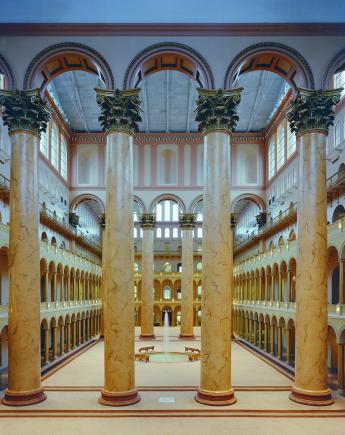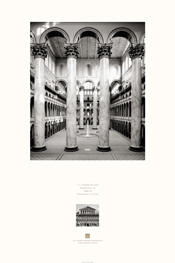Location: 401 F St NW, Washington, DC 20001
History
The Pension Building, now the National Building Museum, stands as a memorial to Civil War veterans. From 1887- 1926, the Pension Bureau distributed $8,300,000 in benefits to 2,763,063 veterans (and their survivors) of the Revolutionary War, the War of 1812, the Mexican War, and the Civil War.
In 1881 the U.S. Congress directed General Montgomery C. Meigs (1816-1892), Quartermaster of the U.S. Army and a graduate of West Point, to develop a fireproof building for the Pension Bureau. Meigs envisioned the building as both office space and as a monument to those who died fighting in the Civil War. In commemoration of those heroes, Caspar Buberl (1834-1899) sculpted a 1200-foot terra cotta frieze depicting the Union’s Army and Navy.
Construction began in 1882 and ended in 1887. Seeking to create a light and airy environment for federal workers, Meigs incorporated numerous ingenious engineering innovations into the structure, his last project. Responsible for such important engineering feats as the Capitol Dome, Meigs considered the Pension Building to be his greatest achievement. Others did not agree, disparaging it as “Meigs’s old red barn.”
When the Pension Bureau became part of the U.S. Veterans Administration in 1930, the U.S. General Accounting Office (GAO) took over the building. An approved expansion plan was abandoned due to concern that an enlarged Pension Building would reduce space for growth of the nearby Courts. By 1950, when GAO moved into its own modern facility, the Pension Building was considered obsolete and demolition was contemplated.
Public perceptions of the building began changing in the late 1950s when an exhibition by the American Institute of Architects promoted it as worth preservation. In 1969 it was listed in the National Register of Historic Places. In 1980 an Act of Congress designated the Pension Building as the site of a new museum celebrating American achievements in the building arts. The National Building Museum opened in 1985, the same year the building was designated a National Historic Landmark.
Architecture
The monumental Pension Building was a technological achievement at the time of its construction in 1882 and a fitting tribute to those who served in the Civil War. The red-brick building, measuring 400 feet by 200 feet, occupies the entire city block bounded by Fourth, Fifth, F, and G Streets, N.W., in downtown Washington, DC.
Massive in size and scale, the Italianate Renaissance Revival building is twenty-seven bays long on the north and south elevations and thirteen bays wide on the west and east elevations. The lower exterior facades are modeled after Antonio da Sangallo’s Palazzo Farnese in Rome. The exterior walls are load-bearing brick, measuring 75 feet high and 2 feet 4 inches thick. They are composed of common brick faced with pressed brick, decorative masonry, and ornamental terra cotta. This was an early use of ornamental terra cotta, which was an affordable substitute for carved stone or iron. The terra cotta frieze designed by Bohemian-born sculptor Caspar Buberl depicts a continuous parade of Civil War military units represented in six themes—infantry, cavalry, artillery, navy, medicine, and quartermaster. The entrances centered on each elevation are defined by projecting brick archways. The main frieze of each entry is ornamented with carved panels depicting the military units of the Civil War. The western entry is the Gate of the Quartermaster, the southern entry is the Gate of the Infantry, the eastern entry is the Naval Gate, and the northern entry is the Gate of the Invalids.
The interior plan of the Pension Building is dominated by a full-height hall or atrium at the center, with interconnecting rooms at the perimeter. The Great Hall is divided into three courts by two sets of four colossal Corinthian columns, supporting the metal and glass roof structure. Each column rises 75 feet, rests on a base 8 feet in diameter, and is crowned by a molded plaster capital and an abacus of cast iron. The cornice has two hundred forty-four niches containing life-size plaster busts representing eight prototypical Americans of the building world. A terra cotta-trimmed circular fountain is located in the center of the Great Hall.
Lining the perimeter of the Great Hall are brick arches that spring from seventy-two cast-iron Ionic columns, creating two levels of open arcaded galleries that serve as corridors to offices on the first and second floors. Four main stairways, centrally located on each side of the building near the entrances, extend from the first to the third floors. The office of the Pension Commissioner on the second floor retains its original fireplace and the only decorated ceiling original to the building.
Numerous technological innovations were incorporated into the building’s design. A fresh air ventilation system was based on the premise that the central atrium could act as a giant flue. The exposed roof structure, ornate fenestration, and the full height of the Great Hall acted as a chimney to exhaust unwanted heat. Air was automatically drawn from the perimeter of the building through the clerestory windows, which were opened by a mechanical system. The large central hall with perimeter offices ensured there were no dark corridors, with daylight and air permeating every space.
In anticipation of use as the National Building Museum, the first renovation phase of the Great Hall was completed in early 1985. The roof was replaced and the facades and terra cotta frieze were restored. As part of the U.S. General Services Administration’s Art in Architecture program, four markers representing themes associated with the building arts were designed in 1990 by sculptor Raymond Kaskey and placed at each corner of the site. In 1991 extensive research was conducted prior to conservation of the Casper Buberl painted terra cotta panels located in the stairwells of the building. Restoration work continued through the 1990s under the direction of the Smith Group.
Significant Events
- 1881: Army Quartermaster General Montgomery C. Meigs designs the Pension Building.
- 1882-1887: The Pension Building is constructed.
- 1930: The Pension Building becomes the U.S. General Accounting Office.
- 1934: Congress authorizes expansion of the Pension Building to continue serving the U.S. General Accounting Office. The plan is not implemented.
- 1950: The U.S. General Accounting Office vacates the building and the U.S. Civil Service Commission becomes the primary tenant.
- 1967: The U.S. General Services Administration commissions a study for the Pension Building and rehabilitation is recommended.
- 1969: The Pension Building is listed in the National Register of Historic Places.
- 1972-1978: The DC Superior Court occupies the building.
- 1980: The building is designated by an Act of Congress as the site of the new National Building Museum.
- 1985: The Pension Building is designated a National Historic Landmark.
Facts
- Architect: Army Quartermaster General Montgomery C. Meigs
- Architectural Style: Italian Renaissance Revival
- Construction Dates: 1882-1887
- GSA Building Number: DC0030ZZ
- Landmark Status: National Historic Landmark
- Primary Materials: Red brick with brick and terra cotta ornament
- Prominent Features: Great Hall with 75-foot high columns; Exterior terra cotta frieze of Civil War military units by sculptor Caspar Buberl
Poster Download
Download the poster [PDF - 396 KB]

 U.S. General Services Administration
U.S. General Services Administration

